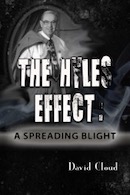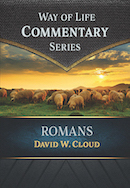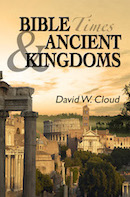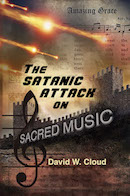866-295-4143, fbns@wayoflife.org
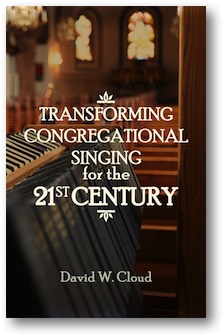
________
Following are some suggestions for choosing a church hymnal.
It is difficult to know how long hymnals will continue to be published, since they aren’t compatible with contemporary worship. I would guess that the market for hymnals has decreased significantly in the past 10 years.
It is essential to use hymnals with wisdom and spiritual discernment. Every song and hymn must be weighed by the Word of God, as we have described in the chapters “Weighing the Music” and “Weighing the Lyrics.”
God’s people must be taught to weigh Christian music by God’s Word, not by their emotions or by tradition. My personal taste is not the fundamental issue.
There are problems with all hymnals. God’s people must be properly informed so they can avoid errors and pitfalls.
The ideal, in our estimation, is for a church to have two hymnals plus a Psalter for psalm singing. One hymnal would be the main pew hymnal. A different hymnal could be purchased by individuals to be used at home and brought to the singing services. We would recommend Living Hymns as the main pew hymnal and Psalms and Hymns and Spiritual Songs for the individual hymnal. Most English-speaking people can afford this if hymn singing is a serious priority.
The following hymnals are listed alphabetically rather than in the order of our personal recommendation.
BIBLE TRUTH HYMNS
Bible Truth Hymns is published by Bible Truth Music headed by Byron Foxx. We can’t recommend Foxx’s ministry with its big tent philosophy and broad, non-discerning musical taste that encompasses contemporary Southern Gospel and lacks sufficiently clear boundaries.
That being said, Bible Truth Hymns is a good hymnal overall with a massive 682 songs, hymns, and choruses. There is a large print edition, which some will find helpful.
The emphasis of Bible Truth Hymns is on revivalist hymns, but this is true of most of the independent Baptist hymnals. We have examined this in the chapter “Weighing the Lyrics.” Revivalist hymnals were written in the revivalist era of c. 1860-1930 and were geared for a mixed-multitude, interdenominational evangelistic forum, such as the crusades of D.L. Moody, R.A. Torrey, and Billy Sunday.
The message and theology tend to be fairly basic in order to facilitate ease of learning and interdenominational ministry. There is not a lot of spiritual and theological depth whereby the minds and hearts of the people are challenged and seriously built up. The edification factor is small. Since there is little substance, they lend themselves to mindless singing. Revivalist songs tend to be light and frothy, more like a theological snack than a solid meal, more skim milk than whole milk, more Rice Krispies than meat and potatoes.
By way of further warning, in Bible Truth Hymns the songs of Thomas Dorsey (i.e., “Precious Lord, Take My Hand”) and Ralph Carmichael (i.e., “Reach Out to Jesus”) are contemporary.
Bible Truth Hymns also has several shallow, touchy-feely songs by the Gaithers (“Because He Lives,” “He Touched Me,” “The Longer I Serve Him,” “The Family of God,” “There’s Something about That Name,” “Something Beautiful”). (See “Bill Gaither’s Disobedience”
www.wayoflife.org/database/bill_gaithers_disobedience.html)
We’re not saying that every song and hymn must be of great theological depth. We need variety. We want songs for new Christians and old, youth and elderly. We want deep hymns as well as choruses and children’s songs.
Examples of the latter in Bible Truth Hymns are “Obedience,” “Dare to Be a Daniel,” “Every Day with Jesus,” “Praise Him, All Ye Little Children,” “My Sins Are Gone,” “He’s Able,” “It’s a Grand Thing to Be a Christian.”
At the same time, Bible Truth Hymns has many hymns with theological depth and spiritual solemnity, such as those by Isaac Watts (“Alas! and Did My Saviour Bleed,” “When I Survey the Wondrous Cross”), Augustus Toplady (“Rock of Ages”), Fanny Crosby (“Draw Me Nearer,” “Take the World, But Give Me Jesus,” etc.), B. Mansell Ramey (“Teach Me Thy Way, O Lord”), Charles Wesley (“And Can It Be,” “O for a Thousand Tongues to Sing”), Samuel Stennett (“Majestic Sweetness Sits Enthroned”), William Cowper (“There Is a Fountain Filled with Blood”), Daniel Whittle (“I Know Whom I Have Believed,” “Moment by Moment,” “Christ Liveth in Me”), William Cushing (“Under His Wings,” “Hiding in Thee”), R. Keene (“How Firm a Foundation”), Lina Berg (“Day by Day”), John Sammis (“Trust and Obey”), Martin Luther (“A Mighty Fortress”), Francis Havergal (“Like a River Glorious,” “Take My Life and Let It Be,” “I Gave My Life for Thee”), Carrie Breck (“Face to Face”), Henry Lyte (“Jesus, I My Cross Have Taken”), Thomas Chisholm (“Great Is Thy Faithfulness,” “Living for Jesus”), William Longstaff (“Take Time to Be Holy”), Elisha Hoffman (“What a Wonderful Saviour”), Charles Gabriel (“My Savior’s Love,” “He Lifted Me”), Edward Mote (“My Hope Is Built”), and Wade Robinson (“Loved with Everlasting Love” or “I Am His and He Is Mine”).
Bible Truth Hymns has eight orchestration editions available for instruments, including flute, oboe, clarinet, bassoon, trumpet, saxophone, french horn, trombone, cello, viola, tuba, and guitar.
Bible Truth Hymns lacks an author index, song dates, and dates for the hymn and tune writers.
GREAT HYMNS OF THE FAITH
Pastor Tim Kelly says, “I still like the Great Hymns of the Faith the best. It is simple, yet no modern songs in it. It is easy to read.”
Some years ago, Mt. Zion Baptist Church of Brogue, PA, changed from Great Hymns of the Faith to Living Hymns after an extensive comparison of those hymnals and Soul-Stirring Hymns. They made the choice based on “the number of hymns and the sing-ability of the songs (keys).”
Like most 20th century Baptist hymnals, Great Hymns of the Faith is weak on the great treasures from the 18th century and heavy on the revivalist era.
There are no hymns by Anne Steele, though she is the prominent female Baptist hymn writer and more than 50 of her hymns appeared in the first two Baptist hymnals (the Bristol collection of 1769 and Rippon’s Selection of 1787). This is no small loss. Great Hymns of the Faith has 13 selections by Isaac Watts and 15 by Charles Wesley, but that is a small sampling from these preeminent hymn writers. Also, a great many stanzas have been removed from the 18th century hymns that are included.
The editor of Great Hymns of the Faith, John Peterson, includes 18 of his own hymns, which tend to fall into a weaker category (i.e., “In My Heart” and “Over the Sunset Mountains”).
Great Hymns of the Faith was out of print for awhile in 2024, but as of November 2025 it is available from the publisher, Brentwood-Benson.
LIVING HYMNS
This is one of our favorite hymnals. It has a massive selection of 887 songs and hymns.
It was first published by Al Smith in 1972. The latest edition is published by Paul Chappell’s Striving Together Ministries.
There is no author index, but I tried to look at the author of every song. There are two by the Gaithers but none by any of the other contemporary worship artists, as far as I could see.
It has hymns that are rarely seen, such as Charles Weigle’s lovely “No One Ever Cared for Me Like Jesus.” There are little-known hymns by old-time fundamentalists such as R.A. Torrey, James Gray, and Lewis Sperry Chafer.
Editions of Living Hymns are available for orchestral instruments, which is a big plus.
Some years ago, Mt. Zion Baptist Church of Brogue, PA, changed from Great Hymns of the Faith to Living Hymns after an extensive comparison of those hymnals and Soul-Stirring Hymns. They made the choice based on “the number of hymns and the sing-ability of the songs (keys).”
Pastor Tim Kelly says, “The second recommendation is Living Hymns. A monstrous amount of hymns, but harder to read. Not well organized. The new one by West Coast has some additions I don’t care for. Plus, I don’t like to support West Coast at this time, for they are taking a leading role in turning to the world.”
Some of the warnings that we give in the chapter “Weighing the Lyrics” are applicable to Living Hymns.
For example, there are many hymns that feature praying to the Spirit. It is true that the Holy Spirit is God, but Christ taught His people to pray to the Father (Mt. 6:9). Paul taught that we pray to God the Father in the name of the Lord Jesus Christ (Eph. 5:20; Col. 1:3) by the Spirit (Eph. 2:18). There is no example in the New Testament of praying to the Spirit or praying for the Spirit to come to us or to fall on us or to fill us or to be poured out upon us. This is heresy which has caused great confusion.
There are many examples of this in Living Hymns: “Breathe on Me, Breath of God” by Edwin Hatch, “Holy Spirit, Light Divine” by Andrew Reed, “Spirit of the Living God” by Daniel Iverson, “Gracious Spirit, Dwell with Me” by Thomas Lynch, “Holy Spirit, Dwell in Me” by Effie Black, “O Breath of Life” by Bessie Head, “Spirit of Power, Anoint Me for Service” by Elisha Hoffman, “Holy Ghost, with Light Divine” by Andrew Reed, “Holy Spirit, Faithful Guide” by Marcus Wells, “Fill Me Now” by Edwood Stokes, “Seal Us, O Holy Spirit” by Isaac Meridith, and “Spirit of God, Descend upon My Heart” by George Croly.
https://strivingtogether.com/collections/living-hymns
MAJESTY HYMNS
Pastor Tim Kelly observes, “I don’t like any of the Majesty hymnals due to the fact that they lead right into bridge music. You cannot get away from that. Very, very dangerous and destructive to people’s music philosophy, which is their philosophy in all things.”
We emphatically don’t recommend Majesty Music’s latest hymnal Rejoice Hymns, as it contains many contemporary worship songs by Getty/Townend and others. It is very sad to see Majesty Music committed to this direction. The changes will be continual, and those who use their material will be in danger of being led astray by their compromise.
https://www.majestymusic.com/church-hymnals/majesty-hymns.html
PSALMS AND HYMNS AND SPIRITUAL SONGS
This excellent hymnal was published in 2018 by Melody Publications.
It is a hymnal for churches that want to take hymn singing seriously. It is a time machine to transport God’s people back to an era that no long exists nationally or culturally, but that can be grasped by individuals, families, and churches that are willing to walk the path of revival.
It is the hymnal today that best reflects the type of congregational singing we have described in Transforming Congregational Singing in the 21st Century,
This hymnal has nearly 1,000 songs, more than 7,000 Scripture references, and 450 historical sketches about hymns and their writers and other interesting and educational comments.
There are many rare hymns, including ones by Baptist pastors of old, such as Benjamin Keach (9), John Leland (5), John Rippon (6), John Ryland (6), Samuel Medley (17), Robert Lowry (27), Samuel Stennett (9), and Charles Spurgeon (1).
There are 13 hymns by the female Baptist poet Anne Steele, who was much appreciated by Rippon and Spurgeon. (Though Steele was a groundbreaking Baptist hymn writer and her hymns approach the spiritual genius of Watts and Wesley, most Baptist hymnals today omit them entirely.)
The hymnal is not only packed with hymns of great spiritual and theological depth from the 18th century (e.g., Watts, Wesley, Steele, Medley, Doddridge, Newton), it also contains a great many Revivalist hymns of the latter half of the 19th century (e.g., Crosby, Sankey, Bliss, Kirkpatrick, Hoffman, Lowry, Doane). We think this is the best of both worlds. Most Baptist hymnals are too light on the 18th century treasures.
There is a larger selection than usual of songs by well-known hymn writers, such as Fanny Crosby (44), Thomas Kelly (24), Isaac Watts (35), Charles Wesley (25), Charles Gabriel (27), Philip Doddridge (7), William Doane (19), William Bradbury (21), John Newton (15), William Cowper (8), William Kirkpatrick (20), Philip Bliss (30), and Ira Sankey (16).
(See the chapters “Learning from the Past” for biographical sketches of these hymn writers.)
This hymnal restores many of the lyrics that have been dropped in other hymnals, such as the seven stanzas of “How Firm a Foundation,” the 18 stanzas of “O for a Thousand Tongues to Sing” (Charles Wesley’s hymn for the anniversary of his conversion), the seven stanzas of “Amazing Grace,” the seven stanzas of “Grace! Tis a Charming Sound,” and the three stanzas that Baptist pastor John Rippon added to “All Hail the Power of Jesus’ Name.”
This hymnal is packed with rare features.
It has invaluable indexes of tunes, meters, contributors, Scriptures, topics, titles, first lines and refrains.
It has a dictionary and a pronunciation guide.
It has 10 blank pages for adding additional songs.
The topical index is extensive and unusually detailed. For example, under Christ, we find the following divisions: the appearing of, the angelic worship of, the ascension of, the birth of, the blood of, the coronation of, the crucifixion of, the death of, the deity of, the earthly ministry of, the exaltation of, the faithfulness of, the gospel of, the grace of, the humility of, the love of, the name of, the omniscience of, the passion of, praise unto, the preciousness of, the priesthood of, the resurrection of, the riches in, the righteousness of, and the second coming of.
There are about 30 hymns on Christ’s Second Coming and the Rapture.
The tune name and meter are given for each selection, thus allowing the songs to be sung by different tunes. For example, 8.6.8.6 tunes (Common Meter) include “Am I a Soldier of the Cross,” “Amazing Grace,” “Come Every Soul by Sin Oppressed,” “Jesus, the Very Thought of Thee,” “Lead Me to Calvary,” “My Faith Has Found a Resting Place,” “O For a Thousand Tongues to Sing,” and “O God Our Help in Ages Past.” These tunes can be interchanged. By the use of meter, known tunes can be used for unknown song lyrics. This is facilitated by the hymnal’s complete tune and metrical indexes. For example, Benjamin Keach’s largely unknown hymns (died 1704) are mostly in the Common Meter so they can be sung to the aforementioned tunes, even though they also have their own unique tunes. (For more about singing by meter see the chapter “Singing the Psalms.”)
The songs contain notations indicating music dynamics (e.g., pp - very soft, ff - very loud, rall - gradually slower, adagio - slowly, allegro - fast).
The spiritual depth of the selections is great. There is nothing contemporary here, nothing shallow and frivolous like so many of the Stamps-Baxter and Southern Gospel and lighter revivalist songs.
This hymnal is a treasure trove for serious, biblical congregational and family singing. It is a powerful resource for expanding a church’s hymn repertoire.
There is also a Shape Note edition, a leather-bound edition, and orchestration editions (flute, oboe, clarinet, trumpet, sax, trombone, bassoon, French horn, bass clarinet, tuba, cello, string bass).
If a congregation considers switching to this hymnal, we would suggest that they make a list of their favorite hymns and checking to see if they are in Psalms and Hymns and Spiritual Songs. Those that are missing could be photocopied from other hymnals and placed in binders.
www.melodypublications.com.
PSALMS AND HYMNS OF REFORMED WORSHIP
This is the 1991 edition of the Metropolitan Tabernacle’s hymnal which is an update and enlargement of the one published by Charles Spurgeon in 1866.
Psalms and Hymns of Reformed Worship features metrical renditions of the Psalms plus hymns by Isaac Watts (166 counting his metrical psalms), Charles Wesley (102), John Newton (41), Henry Lyte (23), James Montgomery (22), Philip Doddridge (19), Francis Havergal (16), William Cowper (14), August Toplady (14), Horatius Bonar (14), Thomas Kelly (12), Charlotte Elliott (9), Anne Steele (9), Harriet Auber (9), John Ryland (6), Nahum Tate (6), Charles Spurgeon (4), and many others.
The hymnal is heavy on the hymn writers of the 18th and early 19th century and very light on the treasures of the later 19th century. For example, there are only three hymns by Philip Bliss and two by Fanny Crosby.
We consider this a serious fault and cannot, therefore, recommend it as a church’s main hymnal. It is, though, an excellent resource for expanding a church’s hymn repertoire.
Alphabetical listing with mp3 files, Author list, Metrical list
https://hymns.countedfaithful.org/hymnDirectory.php
REJOICE HYMNS
See Majesty Hymns.
SONGS AND HYMNS OF REVIVAL
Songs and Hymns of Revival has a large selection, though it tends more toward the lighter revivalist tradition and Southern Gospel.
We don’t recommend Songs and Hymns of Revival as a main hymnal. We include it only because editions are available for orchestra which might be helpful in some cases.
We don’t recommend the Southern Gospel music published by Golden State Baptist College.
North Valley Publications, Santa Clara, CA, www.nvpublications.org
At the bottom of the following page is a link to a song list for Songs & Hymns of Revival:
https://nvpublications.org/collections/songs-and-hymns-of-revival/products/songs-hymns-of-revival-burgundy-hardback-hymnal
- Receive these reports by email
- www.wayoflife.org
______________________
Sharing Policy: Much of our material is available for free, such as the hundreds of articles at the Way of Life web site. Other items we sell to help fund our expensive literature and foreign church planting ministries. Way of Life's content falls into two categories: sharable and non-sharable. Things that we encourage you to share include the audio sermons, O Timothy magazine, FBIS articles, and the free eVideos and free eBooks. You are welcome to make copies of these at your own expense and share them with friends and family. You may also post parts of reports and/or entire reports to websites, blogs, etc as long as you give proper credit (citation). A link to the original report is very much appreciated as the reports are frequently updated and/or expanded. Things we do not want copied and distributed are "Store" items like the Fundamental Baptist Digital Library, print editions of our books, electronic editions of the books that we sell, the videos that we sell, etc. The items have taken years to produce at enormous expense in time and money, and we use the income from sales to help fund the ministry. We trust that your Christian honesty will preserve the integrity of this policy. "For the scripture saith, Thou shalt not muzzle the ox that treadeth out the corn. And, The labourer is worthy of his reward" (1 Timothy 5:18). Questions? support@wayoflife.org
Goal:Distributed by Way of Life Literature Inc., the Fundamental Baptist Information Service is an e-mail posting for Bible-believing Christians. Established in 1974, Way of Life Literature is a fundamental Baptist preaching and publishing ministry based in Bethel Baptist Church, London, Ontario, of which Wilbert Unger is the founding Pastor. Brother Cloud lives in South Asia where he has been a church planting missionary since 1979. Our primary goal with the FBIS is to provide material to assist preachers in the edification and protection of the churches.
Offering: Offerings are welcome if you care to make one. If you have been helped and/or blessed by our material offerings can be mailed or made online with with Visa, Mastercard, Discover, or Paypal. For information see: www.wayoflife.org/about/makeanoffering.html.


